The Original Dry Bag Steak | Make Artisan Dry Age Steak at Home › Forums › Dry Aging Steak › Dry Aging Steak with UMAi Dry® › Humidity Problems
- This topic has 16 replies, 6 voices, and was last updated 12 years ago by
Rob Babcock.
-
AuthorPosts
-
November 30, 2012 at 7:24 pm #1489
Brian
MemberHello: I began on 11/6 – 2 strip loins and one boneless rib eye. All three bags had good seals / contact with the meat.
I’m now 24 days in: the temperature has been from 31.5 to 37.9 the entire time. I’m using a full size new refrigerator dedicated to dry aging, with open wire racks.
The fat has hardened on top but the end cuts of meat are still soft. Based on other photos and research I’d expect a crust would have formed on the ends. The odor is pleasant and nutty.
In looking back at the humidity ranges it seems to be high: 60% to a high as 90% humidity and right now it’s 85%. That seems high and would seem to explain a lack of crust???
Two questions:
1) Is the meat safe to continue at these humidity levels or should I pull the meat and get the humidity issue (if it is an issue) remedied and begin again? I was planning on letting loin one go 28+ days, rib eye 45 and loin 2 65.
2) How can I lower the humidity?
Thanks in advance!
I’ll try and post photos if that helps?
December 1, 2012 at 1:20 am #6415Ron Pratt
MemberBrian, first of all welcome to our forum – sounds like with 3 sub-primals already aging plus buying a new dedicated refrig then you jumped in with both feet!
I’m not sure I can answer all of your questions but perhaps if we address several points we can figure this out together. First of all you said this was a new full size refrig so I’d think it would be working properly – however your humidity levels sounds like drying aspect of the refrig is not working. Are you using some monitoring devices that you know are trustworthy and accurate? If so I’d get a service call lined up soon.
A couple solutions that might work would be to set the temperature colder so the compressor cycles more frequently and also merely opening and closing the refrig at least a couple times a day would allow an exchange of the air. You might even want to move the meat around as well as flip it over..
Seems strange that the fat side would seem hardened, but the ends remain soft – are they really that soft or are you pressing really hard?
The smell you mentioned sounds proper so you probably are OK, but the moisture loss won’t be as high as normal. BTW have you actually re-weighed the pieces to check what the lost has been so far?
And lastly yes posting some pictures might help.
Ron
December 1, 2012 at 8:54 am #6416Ron Pratt
MemberBrian,
I was kind of hoping you would reply back as I’m trying to help you.
Like many things in life I know just enough to be dangerous! :laugh: – but I believe the moisture removal is part of the compressor function with a heater that captures the moist air and actually some heat “burns off” the moisture. I wonder now if that exchanger which dissipates on the outside of the unit is blocked somehow in your new refrig. The term is Frost Free nowadays and in the old units the moisture would stay inside and turn to frost, which would continue to build up into solid layers of ice.
Ron
December 1, 2012 at 9:06 am #6417Brian
MemberHi Ron: Thanks so very much for your reply, I was awaiting more detail before I replied. Well bad news, I purchased two more hydrometers and I’m in the 80% no matter what device I read.
Again, the meat and fridge smell great but clearly I have far too much moisture to achieve the desired results.
The fridge I purchased was fairly inexpensive, is it possible it’s not “frost free” ?
I’ll do some research into that.
I’m at at loss….
December 1, 2012 at 9:57 am #6418Ron Pratt
MemberBrian, I think you just answered your own set of questions – either it is not frost free or it is not working properly. Not in your case, but that’s the reason that the little dormitory type refrigerators are NOT recommended for aging. Those will cool the beer and sodas, but do not have the features needed for proper aging over the period of weeks necessary. Ron
December 1, 2012 at 11:49 am #6419Dr. Frederick Howard
MemberRon,
I know this doesn’t have anything to do with the topic, but Wednesday the 5th is my 60th day. Yours, I believe, is the day before. Sometime after processing the ribeye and sirloin I’m going to have a tasting gathering where my guests will sample the following: 28 dry aged sirloin; 60 day dry aged sirloin and ribeye; and a 42- day wet aged ribeye. Now before you castigate me for having wet aged along with dry aged, remember this is what I did before discovering dry aging. Then I think I’ll be able to play with the big boys. Hahaha.
DocDecember 1, 2012 at 6:28 pm #6420Brian
MemberRon- thank you.
It appears my fridge is “frost free” but perhaps the components do not have ability to bring down humidity.
You think it’s worth a service call or it simply “it is what it is “?By the way : what is the appropriate humidity level? A quick check of my household fridge gave me a 50% humidity reading. Is that pretty standard ?
On another note: what do you think I should do with the 3 sub primals that have been “aging” three weeks in these conditions?
Thank You
December 1, 2012 at 8:58 pm #6421Thea
KeymasterHello, Brian.
You are certainly having to fuss with this humidity issue more than the average bear! The household fridge is certainly operating at more “normal’ humidity levels. I would really appreciate if you would post a picture of your refrigerator set-up.
The very best advice I can offer is that you trust your nose–which you are already doing. So long as your temperature has been constantly within the safe range–something you have confirmed–you should have no problem. It may just be that you will not have pulled out as much moisture as would be optimal. The fact that the fat crusted, you can be certain that have reduced the moisture level all around.
How much longer are you planning to age? I would certainly flip the meat over and put it fat cap down for the rest of the aging period.
And if you can–send beauty shots!! 😉
–Thea
December 1, 2012 at 10:46 pm #6422Ron Pratt
Memberquote freddh” post=3171:Ron,
…Now before you castigate me for having wet aged along with dry aged…DocDoc, if you really fear criticism then you ought to invite me to your tasting party on the 5th! :laugh: Ron
December 2, 2012 at 4:26 am #6424Ray
MemberIf you are using a full size fridge for only three pieces of meat. The majority of the fridge volume is
air which does not hold cold. Put jugs of water in fridge to hold the cold. You shouldn’t have a 6 or 7
degree swing if you’re not needing to open the door as with a normal use fridge. Your cape cod humidity clocks in at
over 80 % today so opening the fridge would seemingly let humidity in rather than letting it out.
May I suggest lowering temp setting and make sure fridge is cycling, actually turning on and off and air circulator actually
moving air over the coils. That’s the only way the fridge can pull water out of the air. Sounds like your dedicated fridge is
probobly in a garage where the ambient temp is between 30 and 50 degrees. Am I right? It might be only going through
a cooling cycle one a day. That’s not working as a fridge but a simple cooler. Ex cape coderDecember 2, 2012 at 5:51 am #6425Thea
KeymasterThank you, Gourmet for the excellent troubleshooting–and context!
December 2, 2012 at 9:46 am #6426Ray
MemberBut, as per Iowa state you’re humidity might be okay. The drybag should protect the meat from mold.
See below.
Series No. FS/MS011
Facts: Meat Science
By F.C.Parrish, Jr., Ph.D.
Department of Animal Science
Iowa State University
Ames, IowaDry aging is the traditional process of placing an entire carcass or wholesale cut (without covering or packaging) in a refrigerated room for 21 to 28 days at 32-34 degrees F. and 100-85% relative humidity, with an air velocity of 0.5 to 2.5 m/sec. All three conditions, although varying widely in commercial practice, are extremely important in the proper postmortem aging of carcasses, as well as beef ribs and loins.
A third method, accelerated aging uses a higher holding temperature with ultraviolet light used to retard microbial grown which would normally occur at higher temperatures. This method, however, has not been used commercially to a significant degree in recent years, due to the extent that vacuum packaged products are subjected to wet aging.
Too much humidity will allow excessive microbial growth, whereas too little will cause excessive shrinkage. Eighty-five percent relative humidity is a happy medium in slowing microbial growth and moisture loss.
December 2, 2012 at 6:55 pm #6427Brian
MemberThanks again for the information, I’ve tried all your suggestions and I’m going to put in a service call to determine why the fridge humidity is high. In the meantime, I do not want to risk having the meat spoil, thus after 28 days I decided to open the loin that based on visual inspection appears different then the other two. First I weighed, started out at 15.6 and now 13.4 = 14% weight loss.

Then I opened her up and was very pleased with the smell, very natural and pleasant – better then it when in that’s for sure!

AS you can see the end cut did dry more then I had thought, though based on other pics I’d expect a firm crust whereas this was fairly soft to the touch. (but based on my humidity…makes sense)
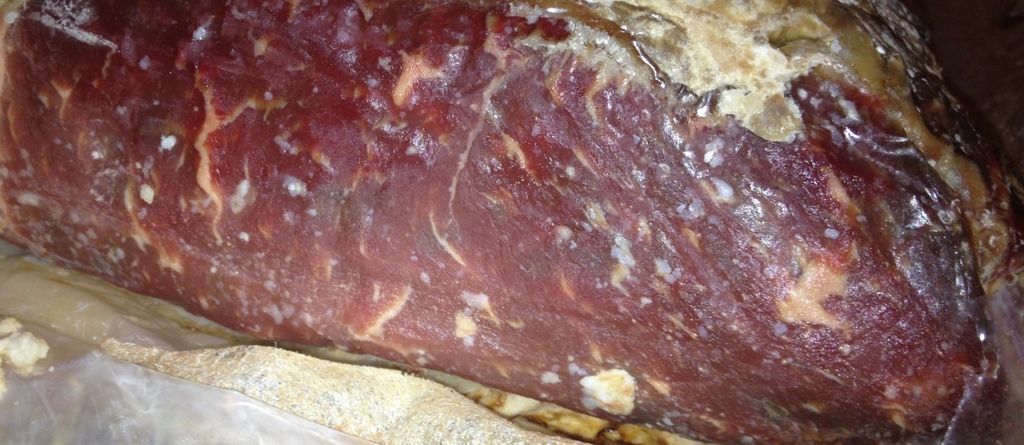
Here is my only concern: I’d say this is mold….and there were a few other spots on the fat cap, though none underneath.
Fat cap:
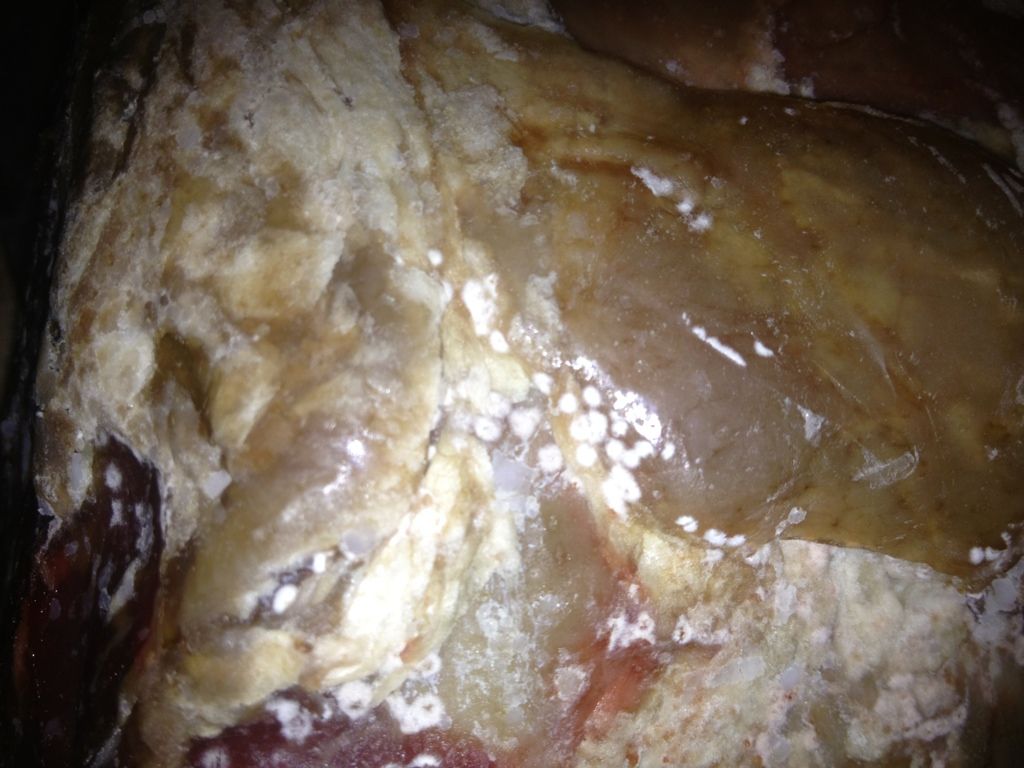
Underneath:

Next I trimmed off all the crusty stuff and suspects:

And Steaked it:

In my opinion the meat is extremely tender looking, the texture is buttery—I’ve read “trust your nose” and my nose tells me this meat is “good”.
I’m interested in hearing any concerns out there. In the meantime I feel good the other two subprimal (with very nice seals) are progressing OK and I hope this week to address the humidity issue.
Brian
December 2, 2012 at 7:37 pm #6428Brian
MemberHere are the other two sub primals: They seem to coming along nicely — today is 26 days.
Rib eye – down 2lbs.


Loin
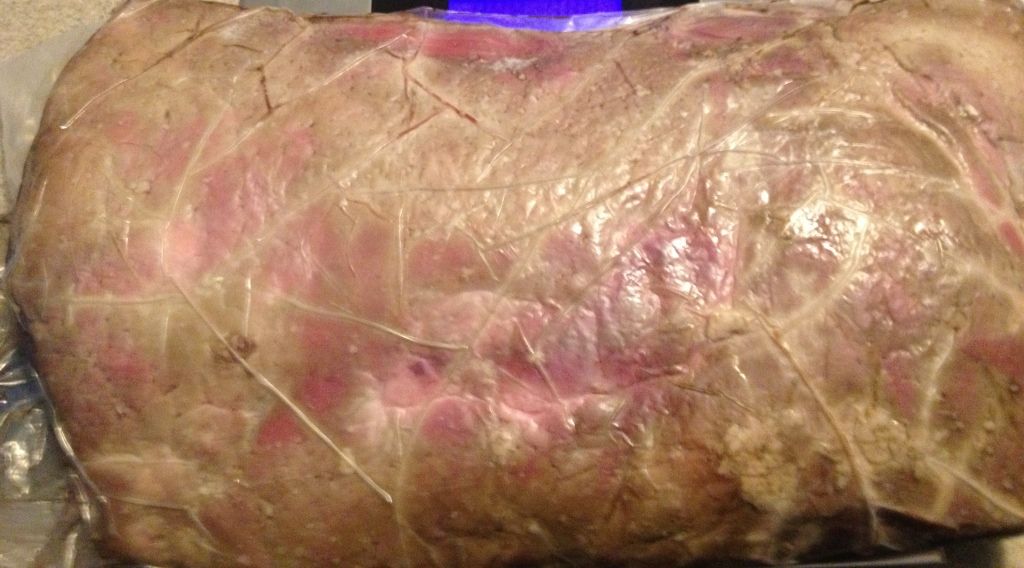
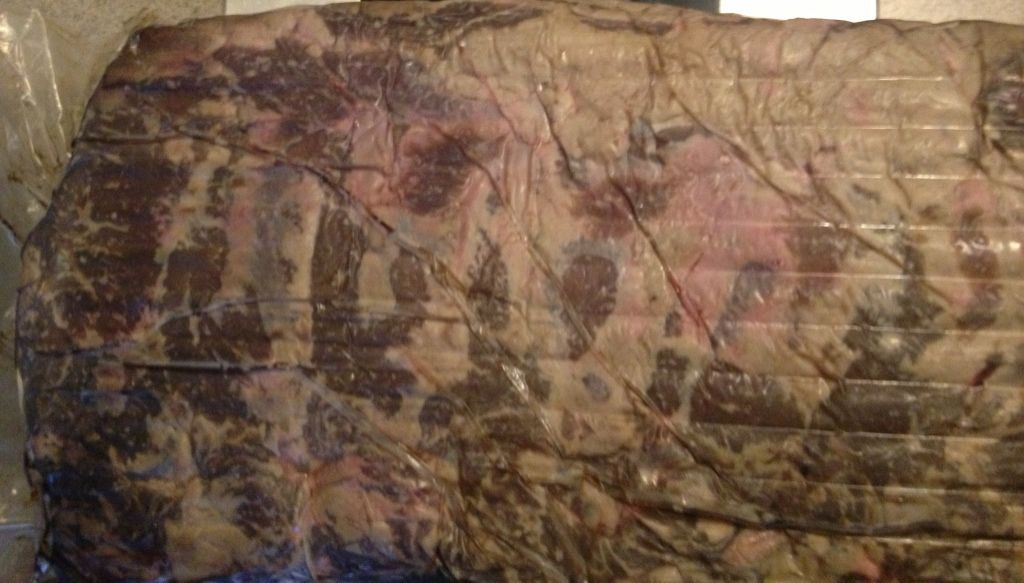
My plan is to hold the rib eye for Christmas: 49 days & the loin 65 days.
December 3, 2012 at 5:28 pm #6430Brian
MemberI added two new hydrometers to the fridge and they showed a 10% drop in humidity then the remote sensor I had been relying on. Most of the day my humidity was in the 50-60% range after I added 5 water jugs to take up the vacant space.
I then bagged a 19lb ribeye and here’s the set up, new rib eye on top (hard to see)

Last night my family and I enjoyed our first home dry aged beef and everyone was very impressed.
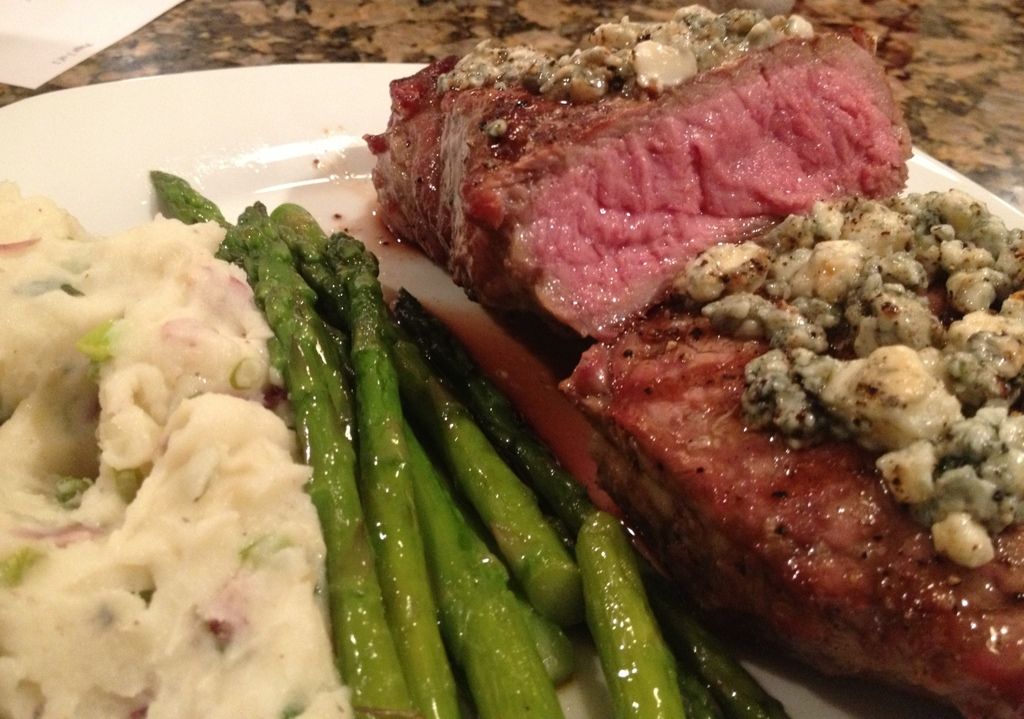
Incidentally, I would never trim that much fat was just being cautious –
Thanks again to the forum for the advice, you are at great resource.
-
AuthorPosts
- The forum ‘Dry Aging Steak with UMAi Dry®’ is closed to new topics and replies.
